Bursitis Injury Facts Part 2:
Normally, bursa are flat and contain very little fluid. An injured bursa however, is swollen with fluid and not so flat anymore.
The most common bursitis injuries are:
Prepatellar Bursitis (housemaid's knee),
Superficial Infrapatellar Bursitis (clergyman's knee),
Trochanteric Bursitis (hip),
Olecranon Bursitis (student's elbow) and
Subacromial Bursitis (shoulder bursitis).
Deep Bursae separate bare areas of bone from overlapping muscles.
Superficial Bursae separate bare areas of bone from skin or tendons.
Deep Bursae develop in the womb. Superficial Bursae develop within months to several years after birth.
Household names for various bursitis injuries include: Popeye's Elbow, Miner's Elbow, Weaver's Elbow, Housemaid's Knee, Hod-Carrier's Shoulders, Dustman's Shoulders, Student's Elbow, and Clergyman's Knee

Bursitis Injury Facts Part 3:
On occasion, bacteria can invade a bursa and cause an infection. An infected bursa is known as septic bursitis and can be life-threatening if left untreated. So make sure you see a physician!
Septic bursitis is most common in knee joints and elbow joints as the bursae in these locations are close to the skin and most susceptible to bacterial invasion.
It is not uncommon for bursitis to be misdiagnosed as arthritis.
Bursitis is best avoided by staying in shape, taking frequent breaks from repetitive or laborious tasks and cushioning joints if on them for long periods (ie. kneepads for gardening).
A Bursa can swell to a surprisingly large size. In cases of heavy swelling, your physician may choose to drain fluid from the swollen bursa. If a lump is present in chronic bursitis cases, excision may be required.
Clergyman's Knee comes from a more upright posture when kneeling in comparison to Housemaid's Knee. Patients suffering from gout or syphilis can be at higher risk of contracting Clergyman's Knee.

| An Overview of Wrist Bursitis
(Ulnar and Radial Bursitis)
What are Wrist *Bursae?
The wrist is made up of eight small bones several tendons and ligaments, and 2 bursae; the ulnar bursa and the radial bursa. The ulnar bursa covers the tendons of the index, middle and ring fingers. The radial bursa covers the thumb tendon and extends to the wrist crease. Infection in the radial bursa and ulna bursa is known as a "horseshoe abscess".
The wrist is constantly in motion throughout the day. Simple everyday activities such as getting dressed, tying shoes, opening a door and preparing dinner are difficult to do when you have a painful wrist. The extensive use of the wrist puts it at a considerable risk for injury; athletes are at an even higher risk: 9% of all athletic injuries involve the wrist.
Your bursae* play an important role in leading a healthy, active life. When the bursae are not irritated and working properly, your joints move smoothly and painlessly. However, when a bursa becomes swollen and inflamed, the condition is known as bursitis. When pressure or friction is too great, excess fluid can build up in the bursa sac causing swelling and inflammation. When a bursa becomes inflamed, moving your wrist becomes very painful and movement can be difficult. Any actions that put pressure on the inflamed bursa in your wrist can increase irritation and cause further inflammation and pain.
*Bursae is the plural form of bursa.
Do You Really have Wrist Bursitis?
Visiting your doctor when you have wrist pain is always recommended, as there are many possible issues that can happen within the wrist and arm. Sometimes, one set of symptoms can result in multiple diagnoses. Some conditions exhibiting symptoms similar to wrist bursitis are as follows:
What Causes Wrist Bursitis?
Repetitive wrist movements (Repetitive Stress Injury) during work or activities that you do frequently (i.e. mouse movements, typing, sewing) is also a major cause of wrist bursitis. Sports with throwing or wrist twisting movements, such as baseball, badminton, and tennis can lead to wrist bursitis.
How Do I Diagnose Wrist Bursitis?
When you are experiencing wrist pain, visiting your doctor is always recommended, as there are many conditions that can cause wrist pain such as carpal tunnel syndrome, a fracture, a sprain, or bursitis.
To begin with, your doctor will gather a medical history about you and your current condition and symptoms. He/she will inquire about the intensity of your wrist pain, the duration of your symptoms and the limitations you are experiencing. Details about what what may have started the pain, when it started, and whether or not you have ever had treatments for this or a similar condition in the past, are very helpful in assessing your injury.
A physical examination will be performed to determine if you have any signs of wrist bursitis or other wrist injury. He/she will visually assess and palpate (feel) the bones and soft tissue in both your wrists to evaluate symmetry and recognize any differences. This will identify any abnormalities, such as swelling, bone deformities, atrophied muscles, redness and/or warmth on the skin. In many cases, the first sign that you have bursitis is swelling in the wrist.
An x-ray may be recommended to rule out a fracture, bone spur, or other foreign body as the cause of your wrist pain.
Therapies that decrease swelling and inflammation, treat scar tissue, and restore strength and movement in your wrist will help you beat bursitis and get rid of your wrist pain.
Wrist Bursitis Symptoms
If you have wrist bursitis you may be experiencing
- Pain in the wrist especially if the wrist is bent back and weight is put on it
- A small lump or swelling at the top or side of the wrist
Wrist Bursitis Home Remedies - What You Need To Know
For non-infectious bursitis, the treatment starts with non-operative options such as
RICE (Rest, Ice, Compression, Elevation) has been recommended for years by doctors, trainers, and other medical professionals to treat the pain and swelling, chronic pain from injury and after any re-injury. Bursitis injuries need rest and time for the tissue to heal. If your bursitis is caused by an infection (septic bursitis), the doctor will probably drain the bursa sac with a needle and prescribe antibiotics to treat the infection. Note that a septic bursa can quickly become life threatening - this is a major reason why you should get to a doctor for diagnosis asap if you haven't already done so.
The good news is that most cases of wrist bursitis will heal with simple home conservative treatments and surgery is often not needed
It's generally understood by doctors and surgeons that surgery will introduce more scar tissue into the tendons and ligaments in your wrist. This added scar tissue will be problematic, requiring visits to the physio clinic and conservative treatment options post-surgery. When it comes to bursitis there's only a few surgical options for treatment - removal of the bursa sac, aspiration or scraping of the bone(s) to allow more room for the new bursa to grow back. This is why surgery is only performed as a last resort for chronic wrist bursitis that won't heal with conservative treatment methods.
Some conservative treatment methods recommended include:
- Rest - This is important for initial recovery; rest and elevation will help reduce pain, swelling and inflammation in the early stages of injury. This can be difficult when you have to carry on with daily activities, but resting and elevating your wrist whenever you can is recommended. During your recovery you will probably have to modify or avoid the activities that put stress on the wrist until your pain and inflammation settle. However, too much rest can also be harmful to such injuries because immobility can eventually cause stiffening in the joints. This is why rest should be used when reducing initial pain and swelling, but should not be considered for more long-term conservative treatment.
 - Avoid Activities that Caused Your Injury - While resting your wrist, it's also important to avoid all activities that may have caused the problem (especially any strenuous or repetitive wrist/forearm/finger movement). Continuing on with regular activities can increase the severity of an injury, turning a mild to moderate case of tissue damage into a downward spiral of worsening damage that may eventually severely impact your life. Also, trying to 'work around' your injury will eventually give rise to over-compensation injuries in other areas of your body.
- Use a Cold Compress or Ice Pack for Inflammation - Cold is very effective at reducing pain and swelling - use at the onset of the injury and during flareups. Immediate pain relief and reduced inflammation should relieve some of the pressure that's being placed on your wrist soft tissue and stop your injury from getting worse.
- Use a Wrist TShellz Wrap® (Circulatory Boost) Once Swelling is Down - After inflammation and/or swelling has been reduced, you can use your own blood flow to maximize your rehabilitation. Improved blood flow to the forearm and wrist in most cases will help improve recovery time while improving overall health of tissue in the area. Promoting blood flow and heat to the treatment area will help to minimize the growth of scar tissue, increase flexibility and thus help combat atrophy.
- Use a Wrist Support Wrap - to increase comfort and prevent further damage you may want to use a wrist support sleeve or brace to help support the wrist joint, reduce risk of further injury and reduce stress on the injured tissue. Some of these are also designed for heat retention to prevent further strain. They can be used until your injury is gone or during active sports for additional stability. Note that these should not be worn at all times, as they can limit muscle development, cut off circulation and impede healing of muscle tissue.
- Avoid Over Compensating for your Injury on your "'Healthy' (Non-Injured) Side - Many people will start holding or carrying objects with their opposite arm to compensate for their tendon injury. Our bodies can adapt easily to any changes, including a wrist injury. This quick adaptation could mean that you're already compensating for your injury without even knowing it!
When you compensate for your injury by using your opposite ('healthy') arm, wrist, shoulder, hand, etc. - then you are putting more load on that side of your body. In many cases, your dominant side was injured (if you're right-handed this would be your right side) so your weaker side is trying to pick up the slack! The pain, stiffness, swelling and inflammation you then get on your 'healthy' side is something referred to as 'over-compensation pain'. Over-compensating for your injury can lead to other injuries and as such, it is important to be aware of how you are compensating so you can be extra careful; if there is an overcompensation flareup, treat this with the same conservative treatment methods to keep in under control.
- Rehabilitative Stretching under supervision of a PT or doctor. The intent of this is to provide you with increased range of motion, pain relief and strengthening of the surrounding tissue of the wrist. Doctors or surgeons typically won't perform a surgery until they feel that their patient has put effort into treating their injury with conservative treatment methods; this may include up to 4 to 6 months of visits to a Physical Therapy clinic. If you haven't experienced any improvement in your condition during that time, surgery may be considered.
- Stretching - Stretching your joint in PT and at home will help you to regain your range of motion much faster than not stretching at all. Stretching in many ways is key maintaining good Range of Motion (ROM) in your joint, and stretching can be made much easier with use of a Wrist TShellz Wrap® before to warm up tissue, and a Cold Compress or Ice Pack treatment after to prevent any return of swelling and inflammation.
Learn More About Bursitis Injuries & TreatmentsI want to learn more about Post-Surgery Recovery I want to learn more about TShellz Wrap® Circulatory Boost I want to learn more about Ice & Heat: Which Is Better For Treatment? I want to learn more about Bursitis Treatments I want to learn more about Bursitis Surgery
FREE SHIPPING ON ALL PRODUCTS CURRENTLY ENABLED
60 DAY TRIAL PERIOD
During your recovery, you will probably have to modify and/or eliminate any activities that cause pain or discomfort at the location of your soft tissue injury until the pain and inflammation settle. The more diligent you are with your treatment and rehabilitation, the faster you will see successful results! Product Advisors are available 9:00 am to 5:00 pm Eastern Standard Time Monday to Friday.
|
Bursitis Inflammation Facts:
Bursitis is the inflammation or irritation of the bursa.
Bursitis is most often caused by repetitive, minor impact on the area, or from a sudden, more serious injury.
Bursitis high-risk activities include gardening, raking, carpentry, shoveling, painting, scrubbing, tennis, golf, skiing, throwing, and pitching.
If bursitis persists and is left untreated, calcium deposits can form within the bursae. These calcium deposits limit range of motion and can lead to a permanently stiff joint.
Incorrect posture at work or home and poor stretching or conditioning before exercise can also lead to bursitis.
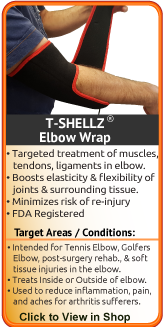

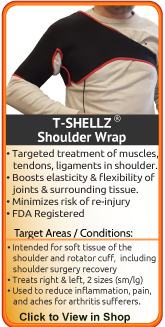

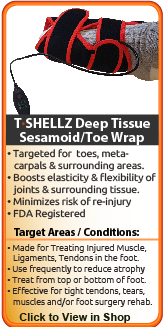


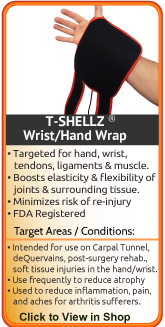
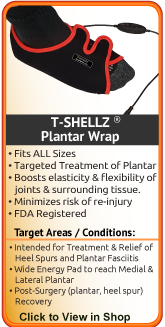

|
















